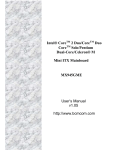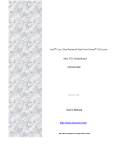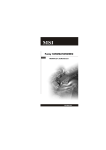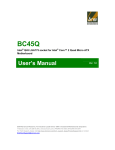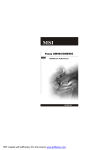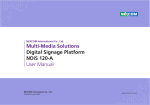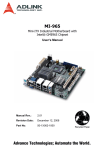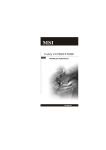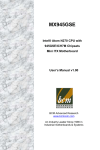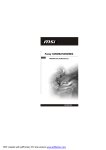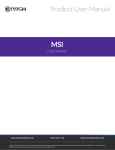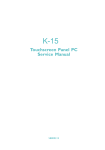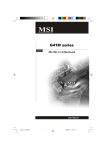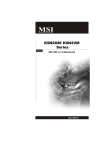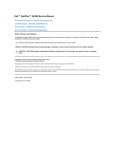Download Advantech Mini-ITX AIMB-250 Series User manual
Transcript
Mini-ITX AIMB-253 Series Intel® Core 2 Duo/Core Duo/ Core Solo Mini ITX Main Board User Manual Copyright Notice The material in this document is the intellectual property of Advantech Co., Ltd.. We take every care in the preparation of this document, but no guarantee is given as to the correctness of its contents. Our products are under continual improvement and we re- serve the right to make changes without notice. Trademarks All trademarks are the properties of their respective owners. Intel® and Pentium® are registered trademarks of Intel Corporation. AMD, Athlon™, Athlon™ XP, Thoroughbred™, and Duron™ are registered trademarks of AMD Corporation. NVIDIA, the NVIDIA logo, DualNet, and nForce are registered trademarks or trade- marks of NVIDIA Corporation in the United States and/ or other countries. PS/2 and OS®/2 are registered trademarks of International Business Machines Corporation. Windows® 95/98/2000/NT/XP are registered trademarks of Microsoft Corporation. Netware® is a registered trademark of Novell, Inc. Award® is a registered trademark of Phoenix Technologies Ltd. AMI® is a registered trademark of American Megatrends Inc. Revision History Revision V1.0 Revision History First release Date June, 2007 Technical Support If a problem arises with your system and no solution can be obtained from the user’s manual, please contact your place of purchase or local distributor. Alternatively, please try the following help resources for further guidance. AIMB-253 User Manual ii Safety Instructions 1. 2. 3. 4. 5. 6. 7. 8. 9. 10. 11. 12. Always read the safety instructions carefully. Keep this User’s Manual for future reference. Keep this equipment away from humidity. Lay this equipment on a reliable flat surface before setting it up. The openings on the enclosure are for air convection hence protects the equip- ment from overheating. DO NOT COVER THE OPENINGS. Make sure the voltage of the power source and adjust properly 110/ 220V before connecting the equipment to the power inlet. Place the power cord such a way that people can not step on it. Do not place anything over the power cord. Always Unplug the Power Cord before inserting any add-on card or module. All cautions and warnings on the equipment should be noted. Never pour any liquid into the opening that could damage or cause electrical shock. If any of the following situations arises, get the equipment checked by service personnel: – The power cord or plug is damaged. – Liquid has penetrated into the equipment. – The equipment has been exposed to moisture. – The equipment does not work well or you can not get it work according to User’s Manual. – The equipment has dropped and damaged. – The equipment has obvious sign of breakage. DO NOT LEAVE THIS EQUIPMENT IN AN ENVIRONMENT UNCONDITIONED, STORAGE TEMPERATURE ABOVE 60°C (140°F), IT MAY DAMAGE THE EQUIPMENT. Caution! Danger of explosion if battery is incorrextly replaced. Replace only with the same or equivalent type recommended by the manufacturer. iii FCC-B Radio Frequency Interference Statement This equipment had been tested and found to comply with the limits for a Class B digital device, pursuant to Part 15 of the FCC Rules. These limits are designed to provide reasonable protection against harmful interference in a residential installation. This equipment generates, uses and can radiate radio fre- quency energy and, if not installed and used in accordance with the instructions, may cause harmful interference to radio communications. However, there is no guarantee that interference will not occur in a particular installation. If this equipment does cause harmful interference to radio or television reception, which can be determined by turn- ing the equipment off and on, the user is encouraged to try to correct the interference by one or more of the measures listed below. • • • • Reorient or relocate the receiving antenna. Increase the separation between the equipment and receiver. Connect the equipment into an outlet on a circuit different from that to which the receiver is connected. Consult the dealer or an experienced radio/television technician for help. Notice 1 The changes or modifications not expressly approved by the party responsible for compliance could void the user's authority to operate the equipment. Notice 2 Shielded interface cables and A.C. power cord, if any, must be used in order to comply with the emission limit. AIMB-253 User Manual iv THIS DEVICE COMPLIES WITH PART 15 OF THE FCC RULES. OPERATION IS SUBJECT TO THE FOLLOWING TWO CONDITIONS: 2. 1.THIS DEVICE MAY NOT CAUSE HARMFUL INTERFERENCE. THIS DEVICE MUST ACCEPT ANY INTERFERENCE RECEIVED INCLUDING INTERFERENCE THAT MAY CAUSE UNDESIRED OPERATION. v WEEE (Waste Electrical and Electronic Equipment) Statement ENGLISH To protect the global env ronment and as an env ronmental st, Advansus must remind you that...Under the European Union (“EU”) Directive on Waste Electrical and Electronic Equipment, Directive 2002/96/EC, which takes effect on August 13, 2005, products of “electri cal and electronic equiment” cannot be discarded as municipal waste anymore and manufacturers of covered electronic equipment will be obligated to take back such products at the end of their useful life. Advansus will comply with the product take back requirements at the end of life of Advansus-branded products that are sold into the EU. You can return these products to local collect on points. AIMB-253 User Manual vi Contents Chapter 1 Getting Started .................................................2 1.1 1.2 Mainboard Specifications.................................................. 2 Mainboard Layout ............................................................. 4 Figure 1.1 AIMB-250 Series Mini ITX Mainboard... 4 Chapter 2 Hardware Setup ...............................................6 2.1 Quick Components Guide ................................................. 6 2.2 CPU (Central Processing Unit) ......................................... 7 Figure 2.1 Quick Components Guide ........................ 6 2.2.1 2.3 2.3.1 2.4 Installing DDRII Modules ............................................ 10 Power Supply .................................................................. 11 2.4.1 2.5 CPU & Cooler Set Installation........................................ 7 Memory ........................................................................... 10 ATX 20-Pin System Power Connector: ATX1............. 11 Figure 2.2 ATX 20-Pin System Power Connector: ATX1 ................................................... 11 Table 2.1 ATX1 Pin Definition .............................. 11 Back Panel....................................................................... 12 Figure 2.3 Back Panel .............................................. 12 Table 2.2 LAN (RJ-45) Jack................................... 13 2.6 Connectors....................................................................... 14 2.6.1 2.6.2 2.6.3 2.6.4 2.6.5 2.6.6 2.6.7 2.6.8 Chassis Intrusion Switch Connector: JCI1 ................... 14 Figure 2.4 Chassis Intrusion Switch Connector: JCI1 ................................................................ 14 44-Pin EIDE Connector: IDE1 ..................................... 14 Figure 2.5 44-Pin EIDE Connector: IDE1 ............... 14 Serial ATA Connectors: SATA1, SATA2.................... 15 Figure 2.6 Serial ATA Connectors: SATA1, SATA2 ................................................................ 15 Audio Amplifier Connector: JAMP1............................ 15 Figure 2.7 Audio Amplifier Connector: JAMP1 ..... 15 Table 2.3 JAMP1Pin Definition ............................. 15 Front Audio Connector: JAUD1................................... 16 Figure 2.8 Front Audio Connector: JAUD1............. 16 Table 2.4 JAUD1 Pin Definition ............................ 16 Fan Power Connectors: CPUFAN1, SYSFAN1........... 17 Figure 2.9 Fan Power Connectors: CPUFAN1, SYSFAN1 ............................................ 17 Front Panel Connector: JFP1 ........................................ 18 Figure 2.10 Front Panel Connector: JFP1.................. 18 Table 2.5 JFP1 Pin Definition ................................ 18 Serial Port Connector: J2 .............................................. 19 vii Figure 2.11 Serial Port Connector: J2........................ 19 Table 2.6 J2 Pin Definition..................................... 20 2.6.9 Front USB Connector: F_USB2 ................................... 21 Figure 2.12 Front USB Connector: F_USB ............... 21 Table 2.7 F_USB2 Pin Definition .......................... 21 2.6.10 Digital IO Connector: J3............................................... 22 Figure 2.13 Digital IO Connector: J3......................... 22 Table 2.8 J3 Pin Definition..................................... 22 2.6.11 Parallel Port Header: JLPT1 ......................................... 23 Figure 2.14 Parallel Port Header: JLPT1 ................... 23 Table 2.9 J3 Pin Definition..................................... 23 2.6.12 LVDS Flat Panel Connector: JLVDS1 ......................... 24 Figure 2.15 LVDS Flat Panel Connector: JLVDS1.. 24 Table 2.10 LVDS Connector (JLVDS1) .................. 24 2.7 Jumpers............................................................................ 26 2.7.1 2.7.2 2.7.3 2.8 Slots................................................................................. 28 2.8.1 2.8.2 2.8.3 Chapter LVDS Power Selection Jumper: J1 .............................. 26 Figure 2.16 LVDS Power Selection Jumper: J1 ........ 26 Table 2.11 LVDS Power Selection Jumper: J1 ........ 26 COM Port Power Jumpers: JCOMP4, JCOMP5 .......... 26 Figure 2.17 COM Port Power Jumpers: JCOMP4, JCOMP5............................................... 26 Clear CMOS Jumper: CLR_CMOS1 ........................... 27 PCI (Peripheral Component Interconnect) Express Slot ...................................................................................... 28 PCI (Peripheral Component Interconnect) Slot ............ 28 PCI Interrupt Request Routing ..................................... 28 3 BIOS Setup .....................................................30 3.1 Entering Setup ................................................................. 30 3.1.1 3.1.2 Control Keys ................................................................. 31 Table 3.1 Control Keys........................................... 31 Getting Help.................................................................. 31 3.2 The Menu Bar.................................................................. 32 3.3 Main ................................................................................ 33 3.4 Advanced......................................................................... 35 Figure 3.1 The Menu Bar......................................... 32 Figure 3.2 The Main Menu ...................................... 33 Figure Figure Figure Figure Figure Figure Figure AIMB-253 User Manual 3.3 3.4 3.5 3.6 3.7 3.8 3.9 Advanced BIOS Features ....................... 36 Advanced Chipset Features .................... 37 Integrated Peripherals ............................. 39 Onboard Device...................................... 41 Super IO Device ..................................... 42 Serial Port Setting................................... 43 Power Management Setup ...................... 44 viii 3.5 PC Health ........................................................................ 46 Figure 3.10 PC Health................................................ 46 Figure 3.11 Smart Fan Setting ................................... 47 3.6 Security............................................................................ 49 Figure 3.12 Security................................................... 49 Table 3.2 Security Option....................................... 49 3.7 System ............................................................................. 50 3.8 Boot ................................................................................. 51 3.9 Exit .................................................................................. 52 Figure 3.13 System .................................................... 50 Figure 3.14 Boot ........................................................ 51 Figure 3.15 Exit.......................................................... 52 ix AIMB-253 User Manual x CHAPTER Getting Started 1 Chapter 1 Getting Started Thank you for choosing the AIMB-253 Series Mini ITX main- board. Based on the innovative Intel® 945GM & ICH7M controllers for optimal system efficiency, the AIMB-253 Series accommodates the latest Intel® Core 2 Duo/Core Duo/Core Solo processors and supports one 240-pin 533/667MHz DDRII DIMM to provide the maximum of 2GB memory capacity. In the entry-level and mid-range market segment, the i945GM-LINI can provide a high-performance solution for today’s front-end and general purpose workstation, as well as in the future. 1.1 Mainboard Specifications Processor Support • • • Intel® Core 2 Duo/Core Duo/Core Solo CPU Supports 3 pin CPU Fan Pin-Header with Fan Speed Control Supports Intel Dual Core Technology to 533/667MHz and up Supported FSB • 533/667MHz Chipset • • North Bridge: Intel® 945GM chipset South Bridge: Intel® ICH7M chipset Memory Support • • DDRII 533/667 SDRAM (2GB Max) 1 DDRII DIMM slot (240pin / 1.8V) LAN • Supports 2 PCI Express Gb Ethernet by Intel 82573L Audio • • HDA Codec by Realtek® ALC888 7.1 channel Compliant with Azalia 1.0 Spec. AIMB-253 User Manual 2 EIDE • • • 1 EIDE port by ICH7M Supports Ultra DMA 100 mode Supports PIO, Bus Master operation mode SATA • • • SATA ports by ICH7M Supports two SATA devices Supports storage and data transfers at up to 150MB/s Connectors • • Back Panel – 2 RJ-45 LAN jacks – 2 USB 2.0 ports – 1 D-Sub VGA connector – 1 serial port – 1 PS2 keyboard/mouse port – Line-In/Line-Out/Mic-In stacked audio jack Onboard Pinheaders – 1 USB 2.0 pinheader (2 ports) – 1 parallel port pinheader – 1 front audio pinheader – 1 LVDS connector – 1 Digital I/O pinheader (16GPIO) – 1 RS232/422/485 COM port header for COM2~COM5 (optional) – 1 front panel pinheader Slots • • 1 PCI Express x16 slot (supports MS-V004 ADD2 DVI Card) 1 PCI 32-bit/33MHz slot Form Factor • Mini ITX 3 Chapter 1 Getting Started Mounting • 4 mounting holes Environmental • • Storage Temperature – Temperature: -10°C ~ 70°C – Humidity: 10% RH ~ 80% RH Operation Temperature – Temperature: 0°C ~ 60°C – Humidity: 80% RH 1.2 Mainboard Layout Figure 1.1: AIMB-250 Series Mini ITX Mainboard AIMB-253 User Manual 4 CHAPTER Hardware Setup 2 Chapter 2 Hardware Setup This chapter provides you with the information about hardware setup procedures. While doing the installation, be careful in holding the components and follow the installation procedures. For some components, if you install in the wrong orientation, the components will not work properly. Use a grounded wrist strap before handling computer components. Static electricity may damage the components. 2.1 Quick Components Guide Figure 2.1: Quick Components Guide AIMB-253 User Manual 6 2.2 CPU (Central Processing Unit) The mainboard supports Intel® Core 2 Duo/Core Duo/Core Solo processors. When you are installing the CPU, make sure the CPU has a heat sink and a cooling fan attached on the top to prevent overheating. If you do not have the heat sink and cooling fan, contact your dealer to purchase and install them before turning on the computer. Note 2.2.1 (1) Overheating will seriously damage the CPU and system. Always make sure the cooling fan can work properly to protect the CPU from overheating. (2) Make sure that you apply an even layer of heat sink paste (or thermal tape) between the CPU and the heatsink to enhance heat dissipation. (3) While replacing the CPU, always turn off the ATX power supply or unplug the power supply’s power cord from the grounded outlet first to ensure the safety of CPU. CPU & Cooler Set Installation 1. Place the CPU on top of the socket. Make sure to align the gold arrow on the CPU with the arrow key on the socket. 2. Push the CPU down until its pins securely fit into the socket. 7 Chapter 2 Hardware Setup 3. On the front end of the CPU socket is a locking mechanism designed into the form of a screw. Make sure that you actuate or deactuate this mechanism with a screwdriver before and after installing the CPU. 4. Release the metal clips on the retention mechanism. Note Mainboard photos shown in this section are for demonstration only and may differ from the actual look of your mainboard. AIMB-253 User Manual 8 5. Mount the cooler set (fan & heat sink bundled) on top of the CPU and fit it into the retention mechanism. 6. Secure the metal clips back to the retention mechanism. 7. Connect the fan power cable from the mounted fan to the 3-pin fan power connector on the mainboard. 9 Chapter 2 Hardware Setup 2.3 Memory The mainboard provides one 240-pin non-ECC DDRII 533/667 DIMM slot and supports up to 2GB system memory. DDRII 240-pin, 1.8V 64x2=128 pin 56x2=112 pin Single-Channel: All DIMMs in GREEN 2.3.1 1. 2. Note 3. Installing DDRII Modules The memory module has only one notch on the center and will only fit in the right orientation. Insert the memory module vertically into the DIMM slot. Then push it in until the golden finger on the memory module is deeply inserted in the DIMM slot. You can barely see the golden finger if the memory module is properly inserted in the DIMM slot. The plastic clip at each side of the DIMM slot will automatically close. Volt AIMB-253 User Manual 10 Notch 2.4 Power Supply 2.4.1 ATX 20-Pin System Power Connector: ATX1 This connector allows you to connect to an ATX power supply. To connect to the ATX power supply, make sure the plug of the power supply is inserted in the proper orientation and the pins are aligned. Then push down the power supply firmly into the connector. ATX1 20 11 1 10 Figure 2.2: ATX 20-Pin System Power Connector: ATX1 Table 2.1: ATX1 Pin Definition PIN SIGNAL 1 3.3V 2 3.3V 3 GND 4 5V 5 GND 6 5V 7 GND 8 PW_OK 9 5V_SB 10 12V Note PIN 11 12 13 14 15 16 17 18 19 20 SIGNAL 3.3V -12V GND PS_ON GND GND GND -5V 5V 5V Power supply of 350 watts (and above) is highly recommended for system stability. 11 Chapter 2 Hardware Setup 2.5 Back Panel Figure 2.3: Back Panel • Serial Port Connector The serial port is a 16550A high speed communications port that sends/ receives 16 bytes FIFOs. You can attach a serial mouse or other serial devices directly to the con- nector. • VGA Connector The DB15-pin female connector is provided for VGA monitors. • Mouse/Keyboard Connector The standard PS/2® mouse/keyboard DIN connector is for a PS/2® mouse/keyboard. • USB Connectors The OHCI (Open Host Controller Interface) Universal Serial Bus root is for attaching USB devices such as keyboard, mouse, or other USB-compatible devices. • Audio Port Connectors These audio connectors are used for audio devices. You can differentiate the color of the audio jacks for different audio sound effects. – Blue audio jack - Line In is used for external CD player, tapeplayer or other audio devices. – Green audio jack - Line Out, is a connector for speakers or headphones. – Pink audio jack - Mic In, is a connector for microphones. AIMB-253 User Manual 12 • LAN (RJ-45) Jack The standard RJ-45 jack is for connection to single Local Area Network (LAN). You can connect a network cable to it. Table 2.2: LAN (RJ-45) Jack LED Color LED State Off On (steady state) Condition LAN link is not established. LAN link is established. Left Orange The computer is communicating On (brighter & pulsing) with another computer on the LAN. Off 10 Mbit/sec data rate is selected. Green On 100 Mbit/sec data rate is selected. Right Orange On 1000 Mbit/sec data rate is selected. 13 Chapter 2 Hardware Setup 2.6 Connectors 2.6.1 Chassis Intrusion Switch Connector: JCI1 This connector connects to a 2-pin chassis switch. If the chassis is opened, the switch will be short. The system will record this status and show a warning message on the screen. To clear the warning, you must enter the BIOS utility and clear the record. CHASSIS GND 1 2 JCI1 Figure 2.4: Chassis Intrusion Switch Connector: JCI1 2.6.2 44-Pin EIDE Connector: IDE1 This 44-pin EIDE connector connects to an optional converter that enables connection to one 44-pin EIDE device and one 40-pin EIDE device, such as hard disk drives, CD- ROM and other EIDE devices. Connect to 44-pin EIDE device IDE1 Connect to EIDE1 Connect to 40-pin EIDE device Figure 2.5: 44-Pin EIDE Connector: IDE1 Note If you install two hard disks on cable, you must configure the second drive to Slave mode by setting its jumper. Refer to the hard disk documentation supplied by hard disk vendors for jumper setting instructions. AIMB-253 User Manual 14 2.6.3 Serial ATA Connectors: SATA1, SATA2 SATA1~SATA2 are high-speed SATA interface ports and support SATA data rates of 150MB/s. Each SATA connector can connect to 1 hard disk device and is fully compliant with Serial ATA 1.0 specifications. SATA1 SATA2 Serial ATA cable Take out the dust cover and connect to the hard disk devices Connect to SATA1/2 Figure 2.6: Serial ATA Connectors: SATA1, SATA2 Note 2.6.4 Please do not fold the Serial ATA cable into 90-degree angle. Otherwise, data loss may occur during transmission. Audio Amplifier Connector: JAMP1 The JAMP1 is used to connect audio amplifiers to enhance audio performance. JAMP1 1 Figure 2.7: Audio Amplifier Connector: JAMP1 Table 2.3: JAMP1Pin Definition PIN 1 2 3 4 Pin Definition AMP_LAMP_L+ AMP_RAMP_R+ 15 Chapter 2 Hardware Setup 2.6.5 Front Audio Connector: JAUD1 The JAUD1 connects to an optional audio bracket that provides extra front panel audio IO jacks. 14 13 2 1 Audio Bracket (Optional) JAUD1 Figure 2.8: Front Audio Connector: JAUD1 Table 2.4: JAUD1 Pin Definition PIN 1 3 5 7 9 11 13 Signal 5V_SB SPDF0 GND LEF_OUT CEN_OUT AUD_GPIO21 SIDE_L AIMB-253 User Manual PIN 2 4 6 8 10 12 14 16 Signal VCC3 NA SPDF1V SURR_OUT_R SURR_OUT_L AUDIO GND SIDE_R 2.6.6 Fan Power Connectors: CPUFAN1, SYSFAN1 The fan power connectors support system cooling fan with +12V. When connecting the wire to the connectors, always take note that the red wire is the positive and should be connected to the +12V, the black wire is Ground and should be connected to GND. If the mainboard has a System Hardware Monitor chipset on-board, you must use a specially designed fan with speed sensor to take advantage of the CPU fan control. SENSOR +12V GND SENSOR +12V GND CPUFAN1 SYSFAN1 Figure 2.9: Fan Power Connectors: CPUFAN1, SYSFAN1 Note Please refer to the recommended CPU fans at Intel® / AMD® official website or consult the vendors for proper CPU cooling fan. 17 Chapter 2 Hardware Setup 2.6.7 Front Panel Connector: JFP1 The mainboard provides one front panel connector for electrical connection to the front panel switches and LEDs. The JFP1 is compliant with Intel® Front Panel I/O Connectivity Design Guide. JFP1 10 Power Switch+ Power LED 2 9 1 + Reset - Switch - HDD + LED Figure 2.10: Front Panel Connector: JFP1 Table 2.5: JFP1 Pin Definition PIN 1 2 3 4 5 6 7 8 9 SIGNAL HD_LED + FP PWR/SLP HD_LED FP PWR/SLP RST_SW PWR_SW + RST_SW + PWR_SW RSVD_DNU AIMB-253 User Manual DESCRIPTION Hard disk LED pull-up MSG LED pull-up Hard disk active LED MSG LED pull-up Reset Switch low reference pull-down to GND Power Switch high reference pull-up Reset Switch high reference pull-up Power Switch low reference pull-down to GND Reserved. Do not use. 18 2.6.8 Serial Port Connector: J2 The J2 is a RS232/422/485 COM port pinheader that connects to serial devices. J2 26 25 2 1 RS232 RS422 RS485 COM2 X V V COM3 COM4 COM5 X V V V X X V X X V = supported X = not supported Serial Port Bracket (Optional) M5 CO M2 CO M4 CO M3 CO Connect to J2 Figure 2.11: Serial Port Connector: J2 19 Chapter 2 Hardware Setup Table 2.6: J2 Pin Definition Voltage Select N/A Serial PIN SIGNAL Port COM2 1 422 RXD1# 3 422 RXD1 5 422 TXD1 7 422 TXD1# 9 GND JCOMP4 COM4 11 NDCD3# (page 213 NSIN3 17) 15 NSOUT3 17 NDTR3 19 NDSR3# 21 NRTS3 23 NCTS3# 25 0V/5V/12V AIMB-253 User Manual 20 PIN SIGNAL 2 4 6 8 10 12 14 16 18 20 22 24 26 422 RXD2# 422 RXD2 422 TXD2 422 TXD2# GND NDCD4# NSIN4 NSOUT4 NDTR4 NDSR4# NRTS4 NCTS4# 0V/5V/12V Serial Voltage Port Select COM3 N/A COM5 JCOMP5 (page 217) 2.6.9 Front USB Connector: F_USB2 The mainboard provides one USB 2.0 pinheader (optional USB 2.0 bracket available) that is compliant with Intel? I/O Connectivity Design Guide. USB 2.0 technology in- creases data transfer rate up to a maximum throughput of 480Mbps, which is 40 times faster than USB 1.1, and is ideal for connecting high-speed USB interface peripherals such as USB HDD, digital cameras, MP3 players, printers, modems and the like. F_USB2 2 1 10 9 USB 2.0 Bracket (Optional) Connected to USB connector Figure 2.12: Front USB Connector: F_USB Table 2.7: F_USB2 Pin Definition PIN 1 3 5 7 9 Note Signal VCC USB0USB0+ GND Key (no pin) PIN 2 4 6 8 10 Signal VCC USB1USB1+ GND USBOC Note that the pins of VCC and GND must be connected correctly to avoid possible damage. 21 Chapter 2 Hardware Setup 2.6.10 Digital IO Connector: J3 The J3 connects to the General-Purpose Input/Output (GPIO) peripheral module. J3 19 20 1 2 Figure 2.13: Digital IO Connector: J3 Table 2.8: J3 Pin Definition PIN 1 3 5 7 9 11 13 15 17 19 Signal VCC3 N_GPIO10 N_GPIO11 N_GPIO12 N_GPIO13 N_GPIO14 N_GPIO15 N_GPIO16 N_GPIO17 GND AIMB-253 User Manual PIN 2 4 6 8 10 12 14 16 18 20 22 Signal VCC5 N_GPIO20 N_GPIO21 N_GPIO22 N_GPIO23 N_GPIO24 N_GPIO25 N_GPIO26 N_GPIO27 NC 2.6.11 Parallel Port Header: JLPT1 The mainboard provides a 26-pin header for connection to an optional parallel port bracket. The parallel port is a standard printer port that supports Enhanced Parallel Port (EPP) and Extended Capabilities Parallel Port (ECP) mode. Parallel Port Bracket (Optional) JLPT1 26 25 2 1 Figure 2.14: Parallel Port Header: JLPT1 Table 2.9: J3 Pin Definition PIN 1 3 5 7 9 11 13 15 17 19 21 23 25 Signal RSTB# PRND0 PRND1 PRND2 PRND3 PRND4 PRND5 PRND6 PRND7 ACK# BUSY PE SLC PIN 2 4 6 8 10 12 14 16 18 20 22 24 26 23 Signal AFD# ERR# PINIT# LPT_SLIN# GND GND GND GND GND GND GND GND GND Chapter 2 Hardware Setup 2.6.12 LVDS Flat Panel Connector: JLVDS1 The LVDS (Low Voltage Differential Signal) connector provides a digital interface typically used with flat panels. After connecting an LVDS interfaced flat panel to the JLVDS1, be sure to check the panel datasheet and set the J1 LVDS Power Selection Jumper to a proper voltage. JLVDS1 2 1 40 39 Figure 2.15: LVDS Flat Panel Connector: JLVDS1 Table 2.10: LVDS Connector (JLVDS1) Signal +12V +12V GND GND LCDVCC DCC DATA VDD ENABLE GND LVDS A0+ LVDS A1+ LVDS A2+ LVDS ACLK+ NC GND LVDS B0+ LVDS B1+ LVDS B2+ LVDS BCLK+ NC GND AIMB-253 User Manual PIN 2 4 6 8 10 12 14 16 18 20 22 24 26 28 30 32 34 36 38 40 PIN 1 3 5 7 9 11 13 15 17 19 21 23 25 27 29 31 33 35 37 39 24 Signal +12V +12V +12V +3V LCDVCC DDC CLK BKLTCTL BKLTEN LVDS A0LVDS A1LVDS A2LVDS ACLKNC GND LVDS B0LVDS B1LVDS B2LVDS BCLKNC GND Note After hardware installation is done, select the LVDS panel type and tune the LVDS backlight in the BIOS Setup Utility. 25 Chapter 2 Hardware Setup 2.7 Jumpers 2.7.1 LVDS Power Selection Jumper: J1 Use this jumper to specify the LVDS power. Figure 2.16: LVDS Power Selection Jumper: J1 Table 2.11: LVDS Power Selection Jumper: J1 PIN 1 2 3 2.7.2 SIGNAL NAME HD_LED + FP PWR/SLP HD_LED - COM Port Power Jumpers: JCOMP4, JCOMP5 These jumpers specify the operation voltage of the serial port COM4 & COM5. 3 1 3 1 JCOMP5 1 3 JCOMP4 +5V +12V 1 3 +5V 1 3 1 3 +12V Figure 2.17: COM Port Power Jumpers: JCOMP4, JCOMP5 AIMB-253 User Manual 26 2.7.3 Clear CMOS Jumper: CLR_CMOS1 There is a CMOS RAM onboard that has a power supply from external battery to keep the data of system configuration. With the CMOS RAM, the system can automatically boot OS every time it is turned on. If you want to clear the system configuration, set the CLR_CMOS1 (Clear CMOS Jumper ) to clear data. 1 CLR_CMOS1 1 1 3 3 Clear Data Note Keep Data You can clear CMOS by shorting 1-2 pin while the system is off. Then return to 2-3 pin position. Avoid clearing the CMOS while the system is on; it will damage the mainboard. 27 Chapter 2 Hardware Setup 2.8 Slots 2.8.1 PCI (Peripheral Component Interconnect) Express Slot PCI Express architecture provides a high performance graphics infrastructure for Embedded Platforms doubling the capability of existing AGP 8x designs with transfer rates of 4.0 GB/s over a PCI Express x16 lane for graphics controllers PCI Express x16 Slot 2.8.2 PCI (Peripheral Component Interconnect) Slot The PCI slot supports LAN cards, SCSI cards, USB cards, and other add-on cards that comply with PCI specifications. At 32 bits and 33 MHz, it yields a throughput rate of 133 MBps. 32-bit PCI Slot 2.8.3 PCI Interrupt Request Routing The IRQ, acronym of interrupt request line and pronounced I-R-Q, are hardware lines over which devices can send interrupt signals to the microprocessor. The PCI IRQ pins are typically connected to the PCI bus pins as follows: 32-bit PCI1 Note Order 1 INT A# Order 2 INT B# Order 3 INT C# Order 4 INT D# When adding or removing expansion cards, make sure that you unplug the power supply first. Meanwhile, read the documentation for the expansion card to configure any necessary hardware or software settings for the expansion card, such as jumpers, switches or BIOS configuration. AIMB-253 User Manual 28 CHAPTER BIOS Setup 3 Chapter 3 BIOS Setup This chapter provides information on the BIOS Setup program and allows you to configure the system for optimum use. You may need to run the Setup program when: • • An error message appears on the screen during the system booting up, and requests you to run SETUP. You want to change the default settings for custom- ized features. 3.1 Entering Setup Power on the computer and the system will start POST (Power On Self Test) process. When the message below appears on the screen, press <Delete> key to enter Setup. Press Delete to enter SETUP If the message disappears before you respond and you still wish to enter Setup, re- start the system by turning it OFF and On or pressing the RESET button. You may also restart the system by simultaneously pressing <Ctrl>, <Alt>, and <Delete> keys. Note (1) The items under each BIOS category described in this chapter are under continuous update for better system performance. Therefore, the description may be slightly different from the latest BIOS and should be held for reference only. (2) Upon boot-up, the 1st line appearing after the memory count is the BIOS version. It is usually in the format: W9642IMS V1.0 031506 where: 1st digit refers to BIOS maker as A = AMI, W = AWARD, and P = PHOENIX. 2nd - 5th digit refers to the model number. 6th digit refers to the chipset as I = Intel, N = nVidia, and V = VIA. 7th - 8th digit refers to the customer as MS = all standard customers. V1.0 refers to the BIOS version. 031506 refers to the date this BIOS was released. AIMB-253 User Manual 30 3.1.1 Control Keys Table 3.1: Control Keys Button <↑> <↓> <←> <→> <Enter> Description Move to the previous item Move to the next item Move to the item in the left hand Move to the item in the right hand Select the item Jumps to the Exit menu or returns to the main menu from a submenu Increase the numeric value or make changes Decrease the numeric value or make changes Load Optimized Defaults Load Fail-Safe Defaults Save all the CMOS changes and exit <Esc> <+/PU> <-/PD> F6 key F7 key F10 key 3.1.2 Getting Help After entering the Setup menu, the first menu you will see is the Main Menu. Main Menu The main menu lists the setup functions you can make changes to. You can use the arrow keys ( ↑↓ ) to select the item. The on-line description of the highlighted setup function is displayed at the bottom of the screen. Sub-Menu If you find a right pointer symbol (as shown in the right view) appears to the left of certain fields that means a sub-menu can be launched from this field. A sub-menu contains additional options for a field parameter. You can use arrow keys ( ↑↓ ) to highlight the field and press <Enter> to call up the sub-menu. Then you can use the control keys to enter values and move from field to field within a sub-menu. If you want to return to the main menu, just press the <Esc >. General Help <F1> The BIOS setup program provides a General Help screen. You can call up this screen from any menu by simply pressing <F1>. The Help screen lists the appropriate keys to use and the possible selections for the highlighted item. Press <Esc> to exit the Help screen. 31 Chapter 3 BIOS Setup 3.2 The Menu Bar Figure 3.1: The Menu Bar Main Use this menu for basic system configurations, such as time, date etc. Advanced Use this menu to set up the items of special enhanced features available on your system’s chipset. PC Health This entry monitors your hardware health status. Security Use this menu to set Supervisor and User Passwords. System This entry shows your system summary. Boot Use this menu to specify the priority of boot devices. AIMB-253 User Manual 32 Exit This menu allows you to load the BIOS default values or factory default settings into the BIOS and exit the BIOS setup utility with or without changes. 3.3 Main Figure 3.2: The Main Menu Date (mm:dd:yy) The date format is <Day>, <Month> <Date> <Year>. Time (hh:mm:ss) The time format is <Hour> <Minute> <Second>. EIDE Channel 0/1/2/3 Master/Slave Press PgUp/<+> or PgDn/<-> to select [Manual], [None] or [Auto] type. Note that the specifications of your drive must match with the drive table. The hard disk will not work properly if you enter improper information for this category. If your hard disk drive type is not matched or listed, you can use [Manual] to define your own drive type manually. 33 Chapter 3 BIOS Setup If you select [Manual], related information is asked to be entered to the following items. Enter the information directly from the keyboard. This information should be provided in the documentation from your hard disk vendor or the system manufacturer. Access Mode Capacity Cylinder Head Precomp Landing Zone Sector The settings are CHS, LBA, Large, Auto. The formatted size of the storage device. Number of cylinders. Number of heads. Write precompensation. Cylinder location of the landing zone. Number of sectors. Halt On The setting determines whether the system will stop if an error is detected at boot. When the system stops for the errors preset, it will halt on for 15 seconds and then automatically resume its operation. Available options are: [All Errors] The system stops when any error is detected. [No Errors] The system doesn’t stop for any detected error. [All, But Keyboard] The system doesn’t stop for a keyboard error. Base/Extended/Total Memory The three items show the memory status of the system. (Read-only) AIMB-253 User Manual 34 3.4 Advanced 35 Chapter 3 BIOS Setup Advanced BIOS Features The sub-menu is used to configure chipset features for optimal system performance. Figure 3.3: Advanced BIOS Features Quick Power On Self Test Select [Enabled] to reduce the amount of time required to run the poweron self- test (POST). A quick POST skips certain steps. We recommend that you normally disable quick POST. Better to find a problem during POST than lose data during your work. Boot Up NumLock Status This setting is to set the Num Lock status when the system is powered on. Set- ting to [On] will turn on the Num Lock key when the system is powered on. Setting to [Off] will allow users to use the arrow keys on the numeric keypad. Typematic Rate Setting This item is used to enable or disable the typematic rate setting including Typematic Rate & Typematic Delay. AIMB-253 User Manual 36 Typematic Rate (Chars/Sec) After Typematic Rate Setting is enabled, this item allows you to set the rate (characters/second) at which the keys are accelerated. Typematic Delay (Msec) This item allows you to select the delay between when the key was first pressed and when the acceleration begins. APIC Mode This field is used to enable or disable the APIC (Advanced Programmable Interrupt Controller). Due to compliance with PC2001 design guide, the system is able to run in APIC mode. Enabling APIC mode will expand available IRQ resources for the system. MPS Version Control For OS This field allows you to select which MPS (Multi-Processor Specification) version to be used for the operating system. You need to select the MPS version supported by your operating system. To find out which version to use, consult the vendor of your operating system. Advanced Chipset Features The sub-menu is used to configure chipset features for optimal system performance. Figure 3.4: Advanced Chipset Features 37 Chapter 3 BIOS Setup DRAM Timing Selectable Selects whether DRAM timing is controlled by the SPD (Serial Presence Detect) EEPROM on the DRAM module. Setting to [By SPD] enables DRAM timing to be determined automatically by BIOS based on the configurations on the SPD. Selecting [Manual] allows users to configure the following fields manually. CAS Latency Time This controls the timing delay (in clock cycles) before SDRAM starts a read command after receiving it. Smaller clocks increase system performance while bigger clocks provide more stable system performance. DRAM RAS# to CAS# Delay This field allows you to set the number of cycles for a timing delay between the CAS and RAS strobe signals, used when DRAM is written to, read from or refreshed. Fast speed offers faster performance while slow speed offers more stable performance. DRAM RAS# Precharge This item controls the number of cycles for Row Address Strobe (RAS) to be allowed to precharge. If insufficient time is allowed for the RAS to accumulate its charge before DRAM refresh, refresh may be incomplete and DRAM may fail to retain data. This item applies only when synchronous DRAM is installed in the system. Precharge Delay (tRAS) The field specifies the idle cycles before precharging an idle bank. System Memory Frequency Use this item to configure the clock frequency of the installed DRAMs. **VGA Setting** The following items allow you to configure the VGA settings of the system. PEG/Onchip VGA Control This setting allows you to select whether to use the onchip graphics processor or the PCI Express card. When set to [Onchip VGA], the motherboard boots up using the onboard graphics processor, even when a PCI Express graphics card is installed. When set to [PEG Port], the motherboard boots up using the PCI Express graphics card, if one is installed. Otherwise, it defaults to the onboard graphics processor. AIMB-253 User Manual 38 When set to [Auto], the BIOS checks to see if a PCI Express graphics card is installed. If it detects that a PCI Express graphics card is present, the motherboard boots up using that card. Otherwise, it defaults to the onboard graphics processor. On-Chip Frame Buffer Size The field specifies the size of system memory allocated for video memory. Boot Display Use the field to select the type of device you want to use as the display(s) of the system. LVDS Panel Type This setting specifies the resolution of the LVDS panel. LVDS Backlight Control This setting controls the brightness level of the LVDS panel backlight. Integrated Peripherals Figure 3.5: Integrated Peripherals 39 Chapter 3 BIOS Setup EIDE Primary Master/Slave PIO The EIDE PIO (Programmed Input/Output) fields let you set a PIO mode for the EIDE devices that the onboard EIDE interface supports. Modes 0 through 4 provide successively increased performance. In [Auto] mode, the system automati- cally determines the best mode for each device. EIDE Primary Master/Slave UDMA Ultra DMA 33/66/100/133 implementation is possible only if your EIDE hard drive supports it and the operating environment includes a DMA driver (Windows ME, XP or a third-party EIDE bus master driver). If your hard drive and your system software both support Ultra DMA/33, Ultra DMA/66, Ultra DMA/100 and Ultra DMA/133, select [Auto] to enable BIOS support. *** On-Chip Serial ATA Setting *** On-Chip Serial ATA This setting specifies the function of the on-chip SATA controller. [Disabled] [Auto] [Enhanced Mode] [SATA Only] Disable SATA controller Automatically determined by BIOS Enable both SATA and PATA, max. 6 EIDE drives supported SATA operates in legacy mode PATA EIDE Mode / SATA Port These settings specify the modes of the PATA & SATA ports. AIMB-253 User Manual 40 Onboard Device Figure 3.6: Onboard Device USB Controller This setting is used to enable/disable the onboard USB controller. USB 2.0 Controller This setting is used to enable/disable the onboard USB 2.0 controller. USB Keyboard/Mouse Support Set to [Enabled] if your need to use a USB-interfaced keyboard/mouse in the operating system that does not support or have any USB driver installed, such as DOS and SCO Unix. Azalia/AC97 Audio Select Azalia is the codename of “High Definition Audio”. This setting controls the High Definition Audio interface integrated in the Southbridge. Audio Amplifier Control This setting disables/enables the audio amplifier. 41 Chapter 3 BIOS Setup Amplifier dB When the Audio Amplifier Control is set to [Enabled], users may adjust the amplifier dB range between the lowest useful output and the largest useful output level. Onboard Ethernet #1/ #2 These settings disable/enable the onboard Ethernet controller. Onboard LAN1/ LAN2 Boot ROM The items enable or disable the initialization of the onboard LAN Boot ROMs during bootup. Selecting [Disabled] will speed up the boot process. Super IO Device Figure 3.7: Super IO Device AIMB-253 User Manual 42 Serial Port Setting Figure 3.8: Serial Port Setting Onboard Serial Port 1 / 2 / 3 / 4 / 5 Select an address for Serial Port 1/2/3/4/5. Serial Port 1 / 2 / 3 / 4 / 5 Use IRQ Select a corresponding interrupt for Serial Port 1/2/3/4/5. Serial Port 2 / 3 Mode These settings specify the transmission mode of the Serial Port 2 & 3. RS-422 defines a Balanced (differential) interface, specifying a single, unidirectional driver with multiple receivers (up to 32). RS-422 will support Point-to-Point, Multi-Drop circuits, but not Multi-Point. RS-485 defines a Balanced (differential) interface, specifying bidirectional, half-duplex data transmission. Up to 32 transmitters and 32 receivers may be interconnected in any combination, including one driver and multiple receivers (multi- drop), or one receiver and multiple drivers. 43 Chapter 3 BIOS Setup Power Management Setup Figure 3.9: Power Management Setup ACPI Function This item is to activate the ACPI (Advanced Configuration and Power Management Interface) Function. If your operating system is ACPIaware, such as Windows 98SE/2000/ME, select [Enabled]. AIMB-253 User Manual 44 ACPI Suspend Type This item specifies the power saving modes for ACPI function. If your operating system supports ACPI, such as Windows 98SE, Windows ME and Windows 2000, you can choose to enter the Standby mode in S1 (POS) or S3 (STR) fashion through the setting of this field. Options are: [S1(POS)] [S3(STR)] The S1 sleep mode is a low power state. In this state, no system context is lost (CPU or chipset) and hardware maintains all system context. The S3 sleep mode is a lower power state where the information of system configuration and open applications/ files is saved to main memory that remains powered while most other hardware components turn off to save energy. The information stored in memory will be used to restore the system when a “wake up” event occurs. Soft-Off by PWR-BTTN This feature allows users to configure the power button function. Settings are: [Instant-Off] [Delay 4 Sec.] The power button functions as a normal power-on/-off button. When you press the power button, the computer enters the suspend/sleep mode, but if the button is pressed for more than four seconds, the computer is turned off. Wake-Up By PCI Card When setting to [Enabled], this setting allows your system to be awakened from the power saving modes through any event on PCI PME (Power Man- agement Event). Power On by Ring An input signal on the serial Ring Indicator (RI) line (in other words, an incom- ing call on the modem) awakens the system from a soft off state. USB KB Wake-Up from S3 This setting allows you to enter “Any Key” (max. 8 numbers) to wake up the system from S3 state. Resume By Alarm When [Enabled], your can set the date and time at which the RTC (realtime clock) alarm awakens the system from suspend mode. 45 Chapter 3 BIOS Setup Date (of Month) Alarm When Resume By Alarm is set to [Enabled], the field specifies the month for Resume By Alarm. Time (hh:mm:ss) Alarm You can choose what hour, minute and second the system will boot up. PWRON After PWR-Fail This item specifies whether your system will reboot after a power failure or interrupt occurs. Available settings are: [Off] [On] [Former-sts] Leaves the computer in the power off state. Leaves the computer in the power on state. Restores the system to the status before power failure or interrupt occurred. 3.5 PC Health Figure 3.10: PC Health AIMB-253 User Manual 46 Smart Fan Setting Figure 3.11: Smart Fan Setting 47 Chapter 3 BIOS Setup Smart System / CPU Fan Temp. Select a temperature setting here, and if the temperature of the CPU / system climbs up to the selected temperature setting, the system will automatically increase the speed of the CPU / system fan to cool down the overheated CPU / system. System / CPU Temp Tolerance You can select a fan tolerance value here for the specific range for the Smart System / CPU Fan Temp. items. If the current temperatures of the fans reach the maximum threshold (the temperatures set in the Smart System / CPU Fan Temp. plus the tolerance values you set here), the fans will speed up for cooling down. On the contrary if the current temperatures reach the minimum threshold (the set temperatures minus the tolerance values), the fans will slow down to keep the temperatures stable. Current System Temp, Current CPU Temperature, System Fan Speed,CPUFan Speed, CPU Voltage, 12V, 5V, DDRII, VBAT (V), 5VSB (V) These items display the current status of all of the monitored hardware devices/components such as CPU voltage, temperatures and all fans’ speeds. AIMB-253 User Manual 48 3.6 Security Figure 3.12: Security Set Supervisor Password Supervisor Password controls access to the BIOS Setup utility. Set User Password User Password controls access to the system at boot. Security Option This specifies the type of BIOS password protection that is implemented. Settings are described below: Table 3.2: Security Option Option [Setup] [System] Description The password prompt appears only when end users try to run Setup. A password prompt appears every time when the computer is powered on or when end users try to run Setup. 49 Chapter 3 BIOS Setup 3.7 System Figure 3.13: System Machine Type/Model, Processor, Processor Cache Size, Processor Speed, System Memory Type, Video Controller, BIOS Date, BIOS Version These items show the hardware specifications of your system. Read only. AIMB-253 User Manual 50 3.8 Boot Figure 3.14: Boot Hard Disk Boot Priority This setting allows users to set the boot priority of the specified hard disk devices. First press <Enter> to enter the sub-menu. Then you may use the arrow keys ( ( ↑↓ ) ) to select the desired device, then press <+>, <-> or <PageUp>, <PageDown> key to move it up/down in the priority list. First / Second / Third Boot Device The items allow you to set the sequence of boot devices where BIOS attempts to load the disk operating system. Boot Other Device Setting the option to [Enabled] allows the system to try to boot from other device if the system fails to boot from the first/second/third boot device. 51 Chapter 3 BIOS Setup 3.9 Exit Figure 3.15: Exit Load Fail-Safe Defaults Use this menu to load the default values set by the BIOS vendor for stable system performance. Load Optimized Defaults Use this menu to load the default values set by the mainboard manufacturer specifically for optimal performance of the mainboard. Save & Exit Setup Save changes to CMOS and exit setup. Exit Without Saving Abandon all changes and exit setup. AIMB-253 User Manual 52































































